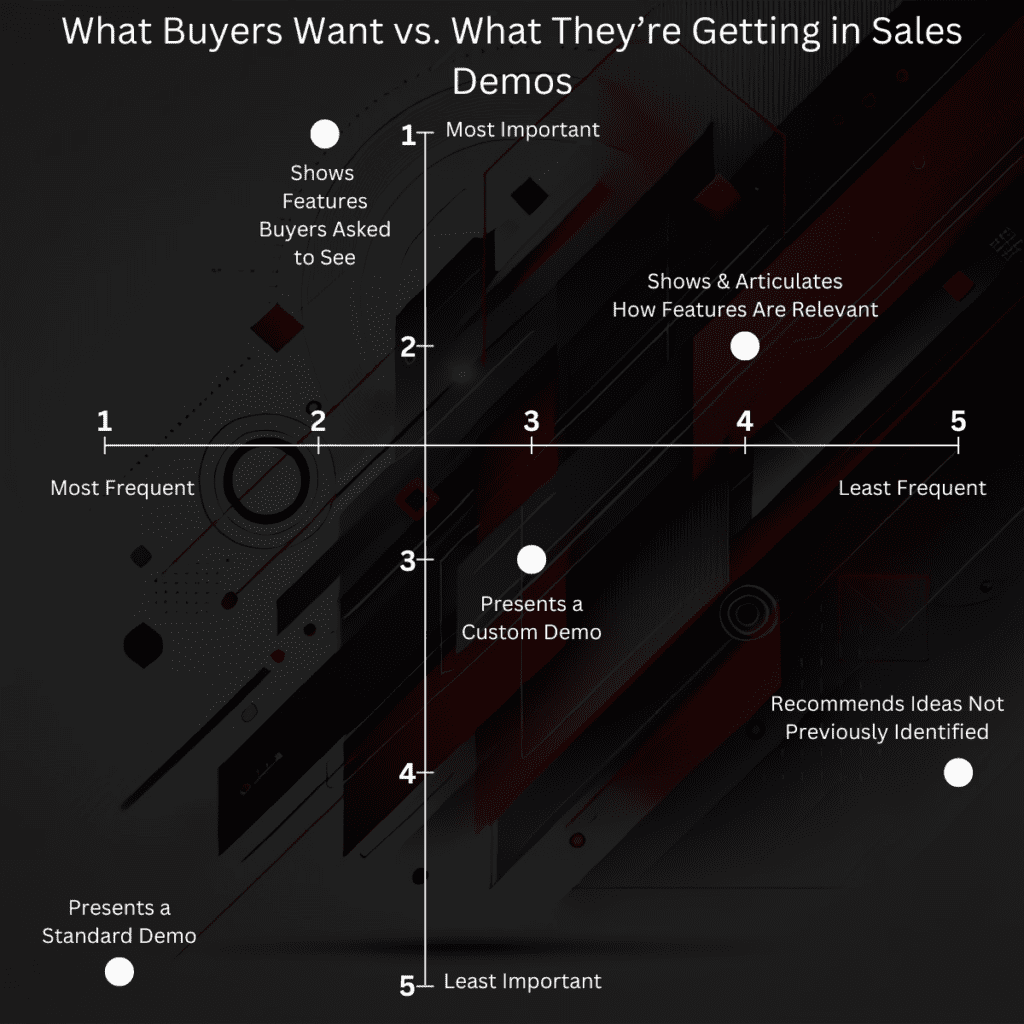Salespeople have long operated under a set of assumptions about what buyers want and need during the sales process. A Sales Growth Company decided to test those assumptions.
We conducted a survey of over 1,200 B2B buyers that revealed some startling disconnects between what buyers want and what they’re actually getting from salespeople. The data we’re going to breakdown today shows this is especially true during sales demos.
What buyers want in sales demos
We asked buyers to rank the following in terms of how important it is for them to see in a discovery: specific features they asked to see, customized solution for identified problems, a standard demo/presentation, clear articulation of feature relevance, new ideas for business improvement. The results show the following hierarchy:
1. Specific features they asked to see
Buyers want salespeople to listen to and respond to explicit requests. Unless the feature they’re asking about is completely irrelevant make sure it’s included in the demo. If it is completely irrelevant, make sure to explain that to the buyer.
2. Clear articulation of feature relevance
Don’t just show a feature. Buyers want to understand how these features are specifically relevant to their organization and how they solve their unique problems.
3. Customized solutions for identified problems
Buyers expect salespeople to tailor their presentations to address the problems and issues uncovered during the initial meetings.
4. New ideas for business improvement
There’s some room for salespeople to bring a fresh perspective, recommending ideas to improve practices the buyer hadn’t previously considered.
5. Standard Demo
Unsurprisingly, standard demos are the least important type of demo for buyers.
Based on this, it’s clear that buyers are looking for a personalized, problem-centric approach to demos. They want sellers to demonstrate an understanding of their problems and then articulate how the product or service and it’s features will address them.
There is an emphasis on relevance and customization showing that buyers are not looking for a specific product. Instead, they want solutions. They want the salespeople to connect the dots for them.
The low ranking of standard demos is particularly telling. It proves that the one-size-fits-all approach, while efficient for sellers, is not helping to move the sale along and may, in fact, be hurting.
The sales demo buyers are actually getting
In the same study, we asked buyers to rank the same factors by what they see most often in their demos. They were ranked as follows:
1. Standard demo/presentation
2. Specific features they asked to see
3. Customized solutions for identified problems
4. Clear articulation of feature relevance
5. New ideas for business improvement
There’s a clear misalignment here. The least wanted type of demo, a standard one, is the most common type of demo buyers receive. Reps are failing to give buyers what they want, they’re failing to show how their solution is different, they’re failing to prove how their product will address the buyer’s unique problems, and they’re failing to demonstrate how it will deliver on the buyer’s desired outcomes.
solution is different, they’re failing to prove how their product will address the buyer’s unique problems, and they’re failing to demonstrate how it will deliver on the buyer’s desired outcomes.
Instead of receiving a customized demo that shows the features a buyer is interested in and demonstrates how additional features are relevant to their situation, buyers are getting a product dump. Sellers are commoditizing their offering, making it harder for buyers to distinguish between one product and another.
Consequences of this misalignment
The gap between what buyers want and what they’re getting during demo presentations has serious consequences for sales organizations:
Lost deals
When salespeople fail to address the problems a buyer is struggling with, they risk losing deals they should have won. Standard demos do little to prove the product can solve the problem so why should the buyer buy?
Commoditization of offering
Relying on the standard demo is a good way to hide the unique value proposition of the product making it difficult for buyers to distinguish between products. Because of this, decisions are made on price rather than value.
Longer sales cycles
When buyers don’t get the information they need to make a decision the sales cycle is going to get longer. Buyers will need time to ask additional questions, explore other options, or make a determination for themselves if the product can solve their problem. The sales rep is on the buyer’s timeline now and sales cycles drag on.
The misalignment between what buyers want and what they’re getting is likely the root of many common sales challenges: lost deals, failing to hit quota, losing to the status quo, long sales cycles, etc. Deals are won and lost, not at the end of the sales but, in the beginning during discovery and the demo.
How salespeople can improve their sales demos
Knowing there’s a disconnect between buyer expectations and current sales practices, the quickest way to improve a seller’s skillset in demos is to:
Focus on customization
Ditch the standard demo. Take the time to tailor the demo for the specific situation of the buyer.
Problems over product
Shift the narrative from the product’s capabilities to it’s ability to solve the problem at hand. Connect each feature demonstration to a relevant challenge and outcome.
Develop discovery skills
to craft an effective demo a salesperson must understand the buyer’s situation. Improving a rep’s ability to ask probing questions, identify problems and impacts, and synthesize the information will pay dividends during demos.
Clearly articulate relevance
Don’t assume buyers will connect the dots between features and the problem. Explicitly explain how each feature relates to their situation and goals.
The buyers have spoken. To meet buyers where they’re at, sales organizations need to reassess their approach to demos and presentations. They must move away from product-centricity and begin presenting demos that directly address each buyer’s unique challenges and desired outcomes.
For sales leaders, this means reevaluating training programs, sales processes, and performance metrics to ensure they support a buyer-focused approach. The organizations that can make this shift will find themselves at a significant competitive advantage.




0 Comments